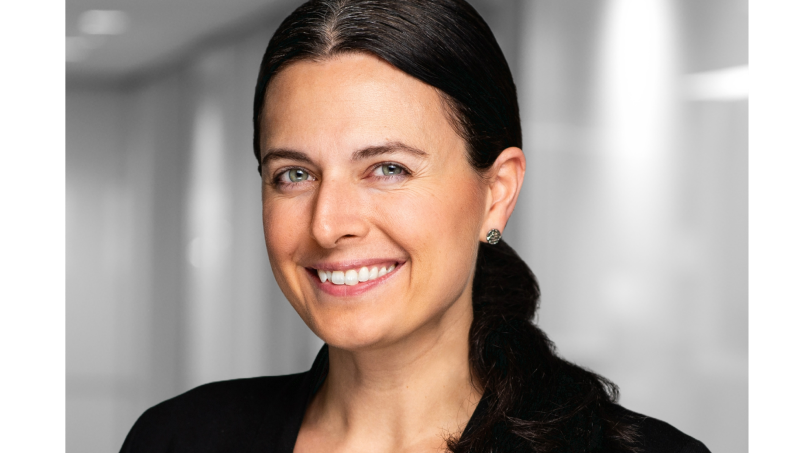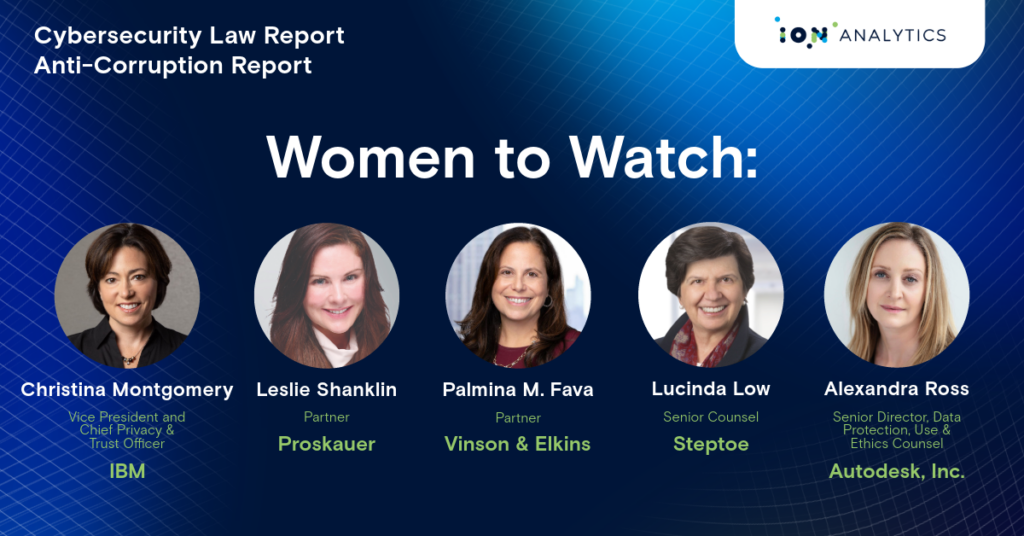Women to watch: contributions, achievements and observations of outstanding female professionals – Part VI
In honor of International Women’s Day, various women at ION Analytics, including Marlene Star at Mergermarket and Dealreporter, Jill Abitbol, managing editor of the Cybersecurity Law Report and Anti-Corruption Report, Sara Tapinekis and Madalina Iacob at Debtwire in the US, Dawn Grocock at Debtwire’s UK office and Lucy Monteiro, who covers the Latin American region for Debtwire, interviewed outstanding women in their respective jurisdictions and the markets that they cover. It is our honor to highlight these women and their accomplishments and contributions to their industries, and share some of their insights and perspectives. These lawyers, advisors and consultants from around the world specialize in private equity, restructuring, mergers and acquisitions, hedge funds, anti-corruption, data privacy, and more. We hope these remarkable women inspire you as much as they do us.
In Part VI of this six-part series, Debtwire legal analyst Sara Tapinekis and court reporters Taylor Harrison and Kennedy Rose help us spotlight notable women in the restructuring field, including (i) Aparna Yenamandra, a partner at Kirkland & Ellis, (ii) Rachel Ehrlich Albanese, a partner at DLA Piper, (iii) Anupama Yerramalli, a partner at Latham & Watkins, and (iv) Olivia Mauro Guthorn, a Managing Director of Opportunities Funds at Oaktree Capital Management.
To view Part I of the ION Analytics’ Spotlight on Trailblazing Women series, please click here.
To view Part II of the ION Analytics’ Spotlight on Trailblazing Women series, please click here.
To view Part III of the ION Analytics’ Spotlight on Trailblazing Women series, please click here.
To view Part IV of the ION Analytics’ Spotlight on Trailblazing Women series, please click here.
To view Part V of the ION Analytics’ Spotlight on Trailblazing Women series, please click here.
Aparna Yenamandra, Partner, Kirkland & Ellis

A restructuring partner in the New York office of Kirkland & Ellis, Aparna’s broad experience includes representations of high-profile Chapter 11 debtors including pharmacy chain Rite Aid Corp, telecommunications company Avaya Inc, and satellite communications company Intelsat. Aparna also represents creditors and other stakeholders in corporate restructurings and has been recognized in the 2022 and 2023 editions of Chambers USA.
What are the biggest changes you’ve seen since you started in the industry?
The single biggest change I’ve seen in the industry since I first started is growth. Growth in the size of restructuring groups, growth in the size of non-restructuring lawyers who spend most of their time on restructuring matters, and explosive growth in financial advisors and restructuring advisors. 12 years ago when I first started, restructuring firms across the board were spread thin on resource allocation. Fast forward to March 2020 when restructurings accelerated at a never-before-seen pace, and firms were actually able to adapt and grow into the pace. Being able to attract more people into restructuring also means we can provide more services in-house to our clients, versus being one of a dozen outside professionals servicing a client during their restructuring.
What do you see as the most notable issue or trend right now in the industry, and do you recall what a big issue or trend was when you started out?
Liability management continues to be a hot trend – by which I mean companies trying to either avoid a Chapter 11 or extend the runway to a Chapter 11 by focusing on liquidity enhancing and debt reduction measures that can be accomplished out of court. People have gotten a lot more creative and aggressive in the way they draft debt documents, and this has opened up the ability to be really creative in these types of transactions. When I first started in this industry (ageing myself now!), fracking had finally started to impact oil and gas and energy companies in a meaningful and rapid way, so at the time the exercise was to find creative ways to hedge against such exposure.
Women have made tremendous strides in our industry over the past 20 years. What would you like to see more of for women, professionally?
I think we have made a lot of progress in attracting talented women into the restructuring space (not just the legal field, but in the financial advisory, and restructuring fields). While recruiting efforts have made huge strides, retention efforts (understandably) are a work in process. Retention is so critical: as a law student trying to pick a path, it was so important for me to see successful, accomplished, women in management positions because it made me feel like I could try and do the same.
Rachel Ehrlich Albanese, Partner and Co-Chair, US Restructuring Practice, DLA Piper

Rachel is the Co-Chair of the US Restructuring practice and a partner in the New York office at DLA Piper. She has vast experience representing debtors, creditors and other stakeholders in both in- and out-of-court restructurings, and participated in dozens of meetings with members and staff of the US Congress to develop the law that ultimately became the Puerto Rico Oversight, Management and Economic Stability Act, which is better known as PROMESA and underlies Puerto Rico’s restructuring process. She is also counsel to LUMA Energy in connection with Puerto Rico Electric Power Authority’s bankruptcy proceedings. Recently, Rachel served as counsel to Chapter 11 debtor Fast Radius, a plastic and metal parts manufacturer, and represented the official committee of unsecured creditorsin the Chapter 11 case of Times Square JV, the owner of the building housing the Crowne Plaza Times Square Manhattan Hotel, where she negotiated a deal with the debtors that resulted in an amended Chapter 11 plan that provided better treatment for unsecured creditors.
What are the biggest changes you’ve seen since you started in the industry?
One of the biggest (and best) changes that I’ve seen since my early days in the restructuring industry over 20 years ago is the increased number of women leaders in big law restructuring practices. I was fortunate to start my career at Weil, which boasted Marcia Goldstein as one of the few women leaders of a restructuring group, along with several notable women partners. Since then, women have ascended to leadership roles at many large firms, including my own role as co-chair of the US Restructuring practice at DLA Piper.
Another significant change is the ascension of technology in our daily practice of law. Being able to send an email on the subway with a Blackberry was a gamechanger in 2004. Twenty years later, we can work from anywhere in the world, logged into our firm network, with access to all of our documents online, having video calls with our clients and colleagues, and generally operating as if sitting in an office.
What do you see as the most notable issue or trend right now in the industry, and do you recall what a big issue or trend was when you started out?
Liability management exercises (LMEs) are trendy. Their long-term efficacy is debatable, as we are seeing quite a few bankruptcy cases involving LMEs—and the subsequent litigation.
Almost twenty years ago, the Bankruptcy Abuse Prevention and Consumer Protection Act (BAPCPA) was passed. Although it primarily was geared toward individuals, it also had a significant impact on Chapter 11 practice.
Women have made tremendous strides in our industry over the past 20 years. What would you like to see more of for women, professionally?
I would like to see law firms, financial advisory firms, and investment banks support professional women with better childcare options. Many women act as primary caregivers to children and other family members, even while working full-time. Firms can help to eliminate the gender gap in our industry by continuing to encourage flexible work options and providing accessible and affordable childcare.
Anupama Yerramalli, Partner, Latham & Watkins

Anu is a partner at Latham & Watkins who has represented debtors, official and ad hoc committees, bondholders, lenders, and other creditors and investors in some of the most high-profile and complex restructurings, both in and out of court. Specifically, she represented Mallinckrodt in its 2020 and 2023 Chapter 11 cases, Virgin Orbit in its 2023 Chapter 11 cases, manufacturer of innovative lighting solutions, Lumileds Holding BV, in its 2022 prepackaged Chapter 11 cases, and drinking glass and tableware manufacturer Libbey Glass, which commenced its Chapter 11 cases in 2020, among others.
What are the biggest changes you’ve seen since you started in the industry?
Pre-filing cooperation and negotiation becoming the norm. When I first started out in private practice in 2009, essentially in the aftermath of the financial crisis, the more common approach was for a company to file for bankruptcy, obtain financing from an institutional bank and then the parties would negotiate with a creditors’ committee to arrive at a solution for the company. But as the cost of Chapter 11 increases and distressed debt is increasingly purchased by hedge funds, these holders are more active in nature and organize earlier, so restructuring support agreements and organized filings have become more of the standard.
This pivot to prearranged restructurings with a subset of funded debtor or senior creditors, or even more coercive liability management tactics are being used to shift dynamics and leverage amongst constituents. These efforts can allow companies to have speedier and more cost-effective restructurings and many times spend less time or no time in Chapter 11. The level of consensus amongst the company and creditor groups reached in these agreements can also help alleviate creditors’ concerns about a drawn out bankruptcy process.
What do you see as the most notable issue or trend right now in the industry, and do you recall what a big issue or trend was when you started out?
Liability management transactions are a hot topic for the industry, which stems from the same trend toward hedge funds becoming more active participants. These transactions allow distressed companies to attract new financing when it might otherwise be unavailable and obtain runway to turnaround operations. These deals can be controversial, because they often come at the expense of one lender over another, and can ultimately lead to complex state or bankruptcy court litigation.
When I began practicing, the industry’s emphasis fell much more on correcting the operations as a whole. That has changed over time, where now many creditors seek fixes to the balance sheet in the quickest way possible, and then have new leadership address operational issues post-bankruptcy. The analysis of the costs and benefits of in- vs. out-of-court, pre-arranged vs. prepackaged, sale vs. plan all drive strategy today, whereas 15 years ago, companies filed and used the automatic stay to drive all parties to the negotiating table.
Women have made tremendous strides in our industry over the past 20 years. What would you like to see more of for women, professionally?
We’ve seen a lot of growth in female leadership within firms in the restructuring space. We need to continue that trend and provide role models for the next generation. The more firms across all parts of the restructuring industry can show women coming up through the ranks, building relationships with clients, and tackling the responsibilities of running restructuring practices, the more we’ll foster an inclusive, encouraging environment for women beginning their practices now. We should continue to strive for female leaders at the helm of practice groups, firms, industry associations and charitable organizations so that the next generation sees the path to achieving these same goals. It always goes noticed when women take the lead, whether in negotiations, the board room or in court. I look forward to the day when that is no longer so notable!
This is where women also need to continue to support other women. Networking, sponsoring, and mentoring are key to the development of the future leaders of our industry. There are several organizations that are at the forefront of promoting these goals. But it should also occur day to day. For the junior women: look for role models across firms, build relationships informally with bankers, financial advisors and other lawyers, do the best work you can do at all times, seek out challenges and diversify your skills, and make yourself known to be a thought leader. For the senior women, in the way you take notice of all rising stars, take notice on your matters of the up and coming female advisors, give feedback, provide speaking opportunities, make referrals, and invite the future leaders to join professional and charitable organizations. Paying it forward will allow the inherent camaraderie amongst female restructuring professionals to be emulated by the next generation.
Olivia Mauro Guthorn, Managing Director, Opportunities Funds, Oaktree Capital Management

Olivia is a managing director in Oaktree’s Opportunities group in New York. In this role, she focuses on opportunities in the healthcare industry. Olivia has over 16 years of experience in opportunistic credit investing including in prior roles at Apollo Global Management, Brookfield Capital Partners, Barclays Capital, and Lehman Brothers. Olivia received a BS in economics summa cum laude from the Wharton School of the University of Pennsylvania.
What are the biggest changes you’ve seen since you started in the industry?
My introduction to distressed debt investing began the week of Lehman Brothers’ bankruptcy filing in 2008, when I was moved to the Distressed Desk as an analyst on Lehman’s Credit team. I don’t think many budding distressed analysts can say that the first bankruptcy hearing they ever listened to was their own company’s! Since the Global Financial Crisis, I’ve seen traditional distressed debt investing evolve significantly into the broader category of opportunistic credit investing. Today’s opportunistic credit investors evaluate a multitude of complex situations where access to capital is limited, including both in distressed liquid credit and in stressed/distressed private credit. This wider opportunity set requires analysts to have both public and private credit skillsets.
The other most significant change I’ve witnessed has been the marked increase in the accessibility of information on stressed and distressed credit, which has been facilitated by technology and service providers. Gone are the days of refreshing the PACER bankruptcy dockets to see important filings or attending bankruptcy court hearings solely in-person. The efficiencies created by these services have enabled investment analysts to appropriately cover this broader opportunity set.
What do you see as the most notable issue or trend right now in the industry, and do you recall what a big issue or trend was when you started out?
We are constantly assessing companies’ abilities to undertake liability management exercises to increase liquidity or capture debt discount to improve their balance sheets. Of particular focus lately have been “double dip” or “triple dip” structures in dropdown transactions. Understanding a company’s options allow us to play offense in providing rescue financings to issuers or play defense if we are already invested in the capital structure.
During the Global Financial Crisis, “cram-up” restructurings, where a junior creditor-led bankruptcy plan is confirmed over the objection of secured creditors, were much more common than in recent years. In a higher-interest rate environment, after more than a decade of ultra-low rates, it will be interesting to see whether reinstatement becomes a more favorable strategy once again.
Women have made tremendous strides in our industry over the past 20 years. What would you like to see more of for women, professionally?
I believe sponsorship is so important for advancement in our industry, particularly for women. In my view, sponsorship and mentorship are different. A mentor provides guidance or shares knowledge, but a sponsor does much more. Sponsors elevate their protégé’s visibility within their organization and externally. Sponsors provide opportunities for career advancement, including expanded responsibilities or exposure to new experiences. I have been very fortunate and grateful to have had sponsors, both men and women, who have advocated on my behalf at various points in my career. It’s so important, in my view, that today’s leaders pay it forward to the next generation of talent.
Women on top of the trends
All of the women interviewed for this article mentioned liability management in response to the question concerning current notable trends in the industry right now. Liability management refers to situations where distressed companies with few, if any, options available to incur additional debt attempt to stave off the need for a Chapter 11 filing by raising new capital on a priming basis through uptiering transactions. In an uptier transaction, a borrower typically incurs additional debt from a subset of its lenders that is higher in priority than (and thereby effectively primes) its existing debt. The new superpriority debt is typically provided by a group of the borrower’s lenders that hold at least 50% of the existing secured debt. The following table highlights recent cases involving litigation over these types of transactions.
We note that on 21 February, Judge Christopher Lopez of the US Bankruptcy Court for the Southern District of Texas appointed Hon Shelley C Chapman (Ret), Senior Counsel, Willkie, Farr & Gallagher, to mediate the disputes concerning Robertshaw US Holding Corp’s uptier transaction and a related, second transaction that, according to Invesco Senior Secured Management, stripped it of its “Required Lenders” status.
In 2022, Hon Shelley C Chapman (Ret) joined Willkie, Farr, & Gallagher as Senior Counsel in the Business Reorganization & Restructuring Department and Chair of the Alternative Dispute Resolution Practice Group. Before that, she served as US Bankruptcy Judge for the Southern District of New York and oversaw a multitude of large, complex Chapter 11 cases, including the largest Chapter 11 case in US history – that of Lehman Brothers Holdings, where she tackled various novel and complex legal issues, including the application of the then relatively untested safe harbor provisions of the Bankruptcy Code as they applied to derivative transactions. During her 12 years (from 2010 to 2022) on the bench, she also oversaw other mega cases, including LightSquared, Sabine Oil & Gas, Aeromexico, and Nine West.
While she was a on the bench, Judge Chapman served as a mediator in various other high-profile cases, including Purdue Pharma and Sears Holdings Corporation. In Sears, her work in mediation yielded a USD 180m settlement to resolve an adversary proceeding with former CEO Eddie Lampert and his investment firm, ESL Investments, that bought the assets out of bankruptcy. She has also been appointed as a mediator in Rite Aid, The Puerto Rico Electric Power Authority, and Endo International.










